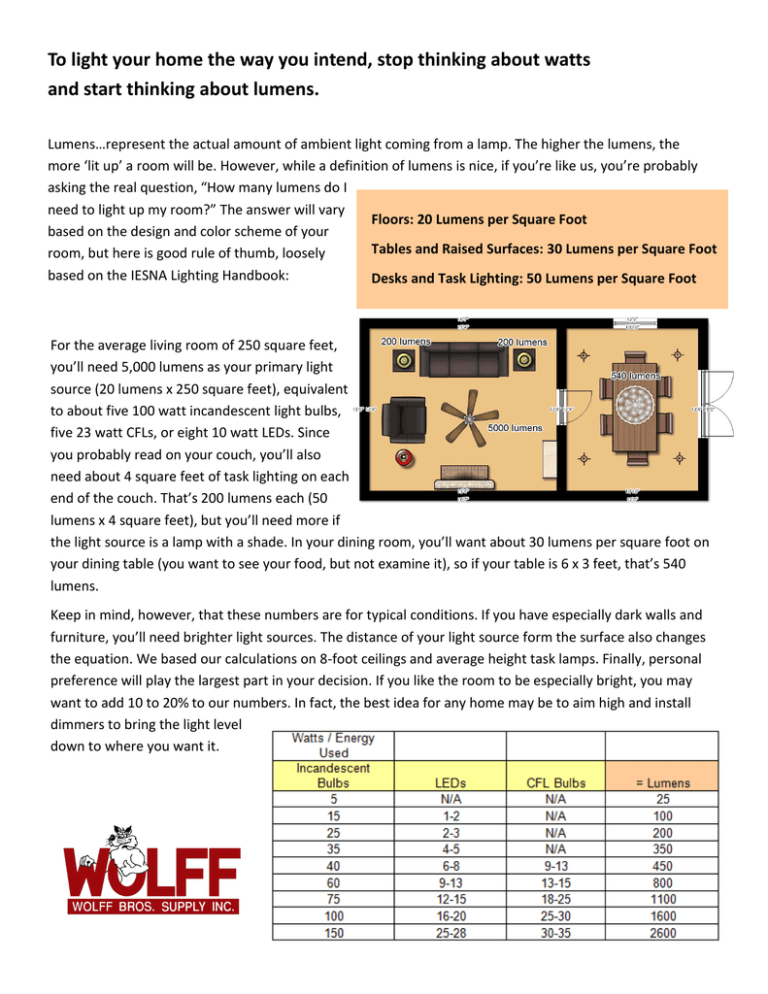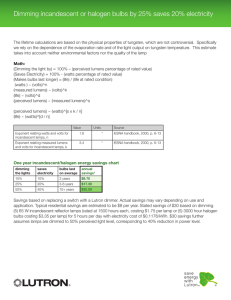To light your home the way you intend, stop thinking about watts and
advertisement

To light your home the way you intend, stop thinking about watts and start thinking about lumens. Lumens…represent the actual amount of ambient light coming from a lamp. The higher the lumens, the more ‘lit up’ a room will be. However, while a definition of lumens is nice, if you’re like us, you’re probably asking the real question, “How many lumens do I need to light up my room?” The answer will vary Floors: 20 Lumens per Square Foot based on the design and color scheme of your Tables and Raised Surfaces: 30 Lumens per Square Foot room, but here is good rule of thumb, loosely based on the IESNA Lighting Handbook: Desks and Task Lighting: 50 Lumens per Square Foot For the average living room of 250 square feet, you’ll need 5,000 lumens as your primary light source (20 lumens x 250 square feet), equivalent to about five 100 watt incandescent light bulbs, five 23 watt CFLs, or eight 10 watt LEDs. Since you probably read on your couch, you’ll also need about 4 square feet of task lighting on each end of the couch. That’s 200 lumens each (50 lumens x 4 square feet), but you’ll need more if the light source is a lamp with a shade. In your dining room, you’ll want about 30 lumens per square foot on your dining table (you want to see your food, but not examine it), so if your table is 6 x 3 feet, that’s 540 lumens. Keep in mind, however, that these numbers are for typical conditions. If you have especially dark walls and furniture, you’ll need brighter light sources. The distance of your light source form the surface also changes the equation. We based our calculations on 8-foot ceilings and average height task lamps. Finally, personal preference will play the largest part in your decision. If you like the room to be especially bright, you may want to add 10 to 20% to our numbers. In fact, the best idea for any home may be to aim high and install dimmers to bring the light level down to where you want it. LUMENS = color temperature Warm White - Use where skin tones and wood tones are important, such as kitchens, bathrooms and recreation rooms. Usually around 2700-3500K. Cool White - Use where color is not as critical, such as offices, work areas, utility rooms, storage areas and garages. Usually around 4100K. Day Light (5000K) - The 5000K lamp produces a much whiter light more closely associated with sun light. The advantage of this light color is that it increases contrast. Black becomes blacker and white becomes whiter. This lamp makes an excellent reading light, can be used in areas where precise tasks are being done, and is great in high bay lighting situations. What’s happening with light bulbs? Lighting and Legislation - The Facts Over the next three years, the minimum efficiency standards for incandescent light bulbs will be raised for bulbs manufactured in or imported into the United States. These changes in standards are primarily the result of requirements in the Energy Independence and Security Act of 2007 (EISA). Many consumers think the incandescent light bulb will no longer be available or manufactured. This is not true. Only inefficient incandescent light bulbs will no longer be manufactured. The table below shows the new standards and effective dates. More efficient incandescent light bulbs are now available in retail stores for purchase. They are called halogen incandescent light bulbs and are 25% more efficient than the inefficient standard incandescent light bulbs. Halogen bulbs are very similar to the inefficient incandescent light bulbs in shape, but have a glass casing around the filament. They come in clear and frosted glass types. In 2012, 100 watt inefficient incandescent light bulbs will no longer be manufactured. But there are many alternatives to choose from that are even more efficient than halogen bulbs.



